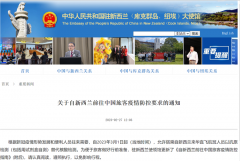加拿大华人论坛 加拿大百科在加拿大找工作 (三) 申请工作
在加拿大
一个全面的工作申请包括:Coverletter - summarizes your qualifications and persuades the employer to meet with youRésumé - provides focused details about your education, experience, and abilities that reinforce the claims made in your letterPortfolio - illustrates your abilities with concrete examples of the work you have doneFollow up card or letter - demonstrates your continued interest in the available position你可以请就近的就业中心的工作人员帮你免费资讯或完善上面的资料。 CoverletterInternet Resources on Cover LettersThe Cover Letter: Practicing Persuasion on the Employerhttp://207.136.91.252/coptions/coverletter.htmlDianne Strickland of Seneca College gives tips on how to write a cover letter that will persuade the employer that you are the best one to address the company's needs. Also emphasized is the importance of highlighting your special abilities.Creating Killer Cover Lettershttp://www.globecareers.com/content/articles/archive/killer-coverletter.htmlHere are some tips on how to create a cover letter that will capture the employer's attention, emphasize the benefits of hiring you, and create a memorable impression.Lettershttp://www.adm.uwaterloo.ca:80/infocecs/CRC/manual/letters.htmlThe University of Waterloo offers comprehensive information about writing cover letters, including a guide to prewriting, outlining specific and general cover letters, as well as a step-by-step description on developing both types of cover letters.Monster.comhttp://content.monster.com/resume/samples/coverletters/letter2/Monster provides a good example of a general inquiry letter. How to Write a Résumé 1. Know your qualifications First complete a thorough inventory of your experience, education, and other qualifications This process will result in a collection of information about your education, work experience, objectives, transferable skills, and interests, which you need for the résumé.2. Write a statement of objectives To do this, Bruce Hunter, Director of Seneca College's Learning Centre at the York University Campus, suggests that you follow these steps:A. Consider the difference between a job and a career in terms of education, experience, and income.B. Ask yourself what jobs you are prepared to do to build the career you want.C. Use your research of the job ads to find out the professionally accepted descriptions of the entry-level positions you'll be qualified to do.D. Write a specific one sentence career objective that describes your short and long term career objectives. Use it to focus your résumé as you write it and to help the employer read it.3. Describe your education Starting with the most recent certificate, diploma, or degree program, list the following items in the education section:Names of institutions attendedDates attendedAccreditation (degree, diploma) obtainedProgram of studyRelevant coursesAwards, scholarships, grade point average.4. Describe your work experience Starting with the most recent employer, describe your work history by listing:Names of companies where presently and previously employedDates of employmentPositions held (job title)ResponsibilitiesAccomplishmentsContacts5. List volunteer work experience Starting with the most recent volunteer organization, describe your community service by listing:Names of companies or associations for which you volunteered or did community service (present and past)Dates of affiliationPositions heldResponsibilitiesAccomplishmentsContacts6. Describe your achievements If you have obtained scholarly, work-related, or sports awards or honours, include them in this section.Work related honoursAcademic awards or scholarshipsSports awards7. List your memberships with professional and non-professional organizations Membership in professional associations shows your commitmentto sustain relationships with other professionals in your field,to uphold standards of practice, andto continue to develop your knowledge.Add memberships to non-professional organizations to demonstrate other interests.8. List your hobbies and interests Hobbies and interests give employers more of a sense of who you are as a person. Try to include hobbies that relate to your career. For example, show your abilities to work independently and in teams by listing interest and hobbies that involve individual and group interests.9. Include a references section As a courtesy, ask for permission from your referees to use their names on your résumé and on application forms. That way, if they are called to speak on your behalf,the referees will be prepared to describe your qualities, andyou will feel more confident in having their support as you apply for jobs.There are three ways to complete this section your résumé. Choose one:Include the following statement: "References will be provided upon request."Include one or two full references, and state that others will be provided at the interview.Include three full references, including:NamesTitlesCompany namesCompany addressesTelephone numberEmail address, if availableInternet Resources on RésumésCollegegrad.com Résumé Templateshttp://www.collegegrad.com/resumes/quickstart.shtmlFind templates for résumés used to apply for jobs in a variety of disciplines at this site.Dealing with a Bad Referencehttp://www.ivillage.com/content/0,1625,13685~65,00.htmlSylvia Ho provides a few tips on how to offset a referee who may not give you a favourable word.Monster.ca Résuméhttp://www.content.monster.ca/resumeMonster.ca provides checklists and instructions for revising key areas of your résumé. Included are a checklist for updating the résumé, a list of résumé don’ts, as well as a list of action verbs and phrases to describe your job responsibilities. In addition, learn how to compensate for weaknesses in your job and education history and how to write a good job objective.Putting to Paper the Skills of Today for Success Tomorrowhttp://www.cacee.com/CO_99/putting.htmIn this article, Stéphane Boudriau explains the differences between the different kinds of résumés that achieve success in today's job market. Chronological, functional, and skills-based résumés are described.Rebecca Smith’s eRésumés and Resourceshttp://www.eresumes.com/Rebecca Smith provides instructions on how to write and format résumés to be posted in various electronic forms, from ASCII to HTML to keyword and scannable résumés. You will also find sample erésumés as well as links to articles by the same author about on line job searching.University of Waterloo Career Development Manualhttp://www.adm.uwaterloo.ca/infocecs/CRC/manual-home.htmlThis site provides a worksheet for reviewing your strengths, skills, weaknesses, knowledge, attitudes, personality, achievements, and goals. In addition, it provides a detailed overview of the major components of a résumé, and guides you in writing your own. Click on Résumés and Letters in the site index. PortfolioA portfolio is a collection of professional looking documents that illustrate and substantiate your work experience, accomplishments, and educational training. These documents can include in-class projects, reports, projects, awards, letters of thanks, transcripts, and photos.The following steps outline how to build a portfolio:Step 1: Collect your documents We recommend that you create a "ME" file. For this purpose, you can use your career file if you have one (for more about building a career file see Identifying Qualifications), or you can create a new ME file altogether. Keep it close to you and add any documents that you might want to use in your portfolio in the future. Include:TranscriptsDiplomasDegreesAwardsLetters of recommendation or thanksReports writtenProjects developedIllustrations, photographs, etc.All documents and illustrations should be in good condition -- if they are not, get new or clean copies. If you have some documents on disk, print a copy, label the disk, and include it in the "ME" file. Don't edit anything out at this point; you can do that later.Step 2: Edit the content Once you've collected enough material, start sorting through it. Organize it into natural categories; for example, group all reports together, and group all educational documents (e.g., transcripts, diplomas, awards) together. Once you've grouped all the material, go through each group and decide which pieces best represent your abilities. You should look for quality and variety to show employers your capabilities. This is the toughest part of building your portfolio!Step 3: Organize the content Decide how you want your documents to be organized in the portfolio. We recommend that your résumé be the first document that employers see. After that, decide if you will present documents to highlight technical abilities, thematic phases, or creative potential. You may decide to emphasize your educational qualifications -- if so, put that section next. You may also decide that the quality of your projects is excellent and you want to emphasize it -- if so, put a projects section next. Continue until you are satisfied with the order of the materials.Step 4: Assemble the portfolio Before you start inserting your documents into the sleeves of your portfolio, decide how it will finally look. We recommend that you include a table of contents for each section. We also recommend that you include page dividers to clearly identify each section. Ensure that your content completely fills the portfolio. There should be no blank pages at the end. If there are, add work, spread the work out more evenly, or remove empty sleeves.Step 5: Field test your portfolio Once you've assembled the portfolio, field test it by showing it to some family, friends, or teachers. Make sure that they are people whose opinion you trust. Ask them to look through the portfolio and give you their impressions aboutthe content,the overall appearance,its organization, andits completeness.Make any revisions necessary, and field test the portfolio again.Step 6: Keep it up to date A portfolio will be useful only if you maintain it. Keep using your "ME" file to collect documents. On a regular basis (every 2 months or so), go through the file, and transfer any relevant documents collected in it to your portfolio. Go through your portfolio at the same time, and remove or replace any documents that do not represent your current abilities or needs.Internet Resources on PortfoliosCareer Portfolios: Telling Your Lifework Storyhttp://changingtimes.com/0598jo15.htmAn interesting article brought to you by Changing Times: The Labour Market Information Webzine for the Career Practitioner.Career Tips: Portfolioshttp://www.bsu.edu/careers/foliotip.html
评论
好希望上面出来的是汉字啊
评论
每个人都要对自己的选择有所坚持有所付出. 超赞 赏 M mikefeng 0$(VIP 0) 7612006-03-28#3 很好
评论
回复: 在加拿大找工作 (三) 申请工作cover letter resuem, good
·加拿大新闻 发现了吗?房贷才是检验牛马的唯一标准
·加拿大新闻 全新奥迪A6L3.0T:2026年上市,外观变化太大?
·加拿大新闻 幕后牵线曝光!万锦自由党议员出手,促成马荣铮跳槽
·加拿大新闻 加拿大大部分地区将迎“白色圣诞”安省魁省概率最高
·加拿大新闻 [评论] 保守党频出状况博励治领导地位岌岌可危
·生活百科 这算不算车道?
·中文新闻 悉尼女子与兄弟争夺继承权后挪用100万澳元

